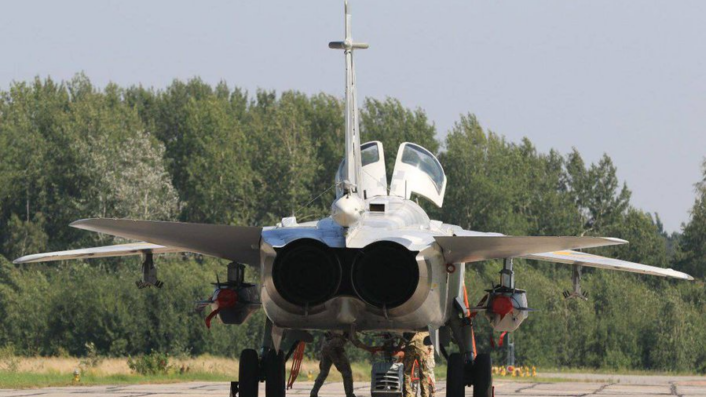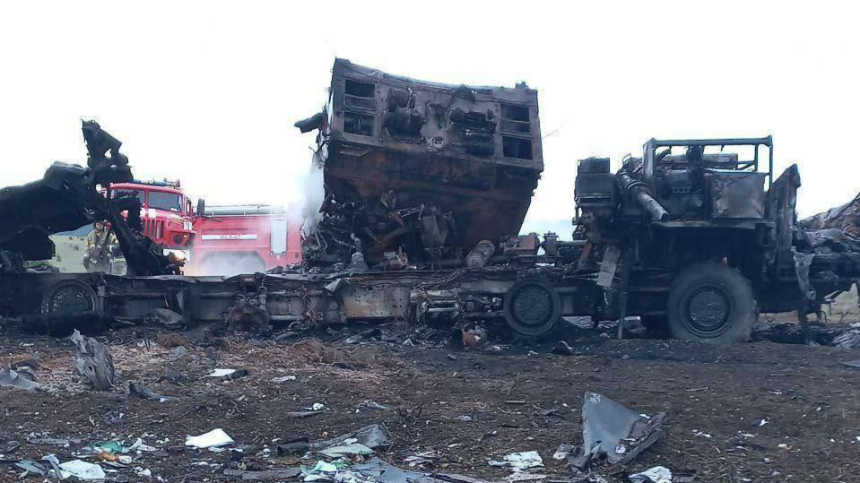The attacks on Russia-held Crimea reflect a wider US strategy to make the peninsula undefendable for Russia, in a way that impacts its operations on land.
Ukrainian and Russian sources reported strikes at a radar station on a mountainside and an air base in Crimea on May 13 and the wee hours of May 15, 2024. Reports from Ukraine said the attack on the Ai-Petri mountain was claimed to have been carried out using the British-French Storm Shadow/SCALP-EG ALCM (Air-Launched Cruise Missile).
Leading Russian defense analysis forums also confirmed the strike on the Belbek air base, and said Ukraine used the MGM-140B ATACMS (Army Tactical Missile System).
Mountainside Radar Station Hit
According to Militarnyi, the Ukrainian Armed Forces hit a radar complex in the Crimean Mountains used by the Russian military on May 13. It quoted a report by Astra media, an Ukraine-leading outfit that possibly reports from Crimea, claiming that the “commander” of Russia’s 3rd Electronic Reconnaissance Regiment on the Bedene-Kyr mountain (an alternate Ukrainian name for the feature).
“Around 6 am, several missiles attacked the Bedene-Kyr mountain in Crimea, as reported by sources in the emergency services of the annexed region,” Militarnyi said. It identified the deceased commander of the unit as “Alexander Kulakov,” Russian serviceman who was reportedly and others wounded. The exact nature and number of casualties however could not be independently verified.
Russia’s Ministry of Defense (RuMoD) did note on May 13 that it shot down four Storm Shadow missiles, but did not specify whether it was over Crimea. Ukraine uses the British-French Storm Shadow/SCALP-EG missiles from its Su-24 Fencer variable-wing fighter-bombers.
Militarnyi added that the radar unit on the mountain was established during the time of the former Soviet Union, as the Radar Center for Long-Range Reconnaissance and Guidance of Air Defense Forces. “The domes of the radar shields in the form of spheres protect the antennas of radar systems from wind and icing and other atmospheric phenomena and precipitation.”
Strike on Belbek Air Base
Footage from a CCTV camera on social media from the midnight of May 15 showed explosions taking place at a distance on the Belbek air base, with ‘OSINTtechnical’ claiming NASA’s FIRMS orbital fire monitoring system detecting “multiple large fires encompassing the southern part of the airfield over a two-hour period.” Newsweek quoted Mikhail Razvozhayev, the Moscow-installed governor of Sevastopol, said there had been a massive Ukrainian missile attack over the port city overnight Tuesday.
💥 Multiple Ukrainian ATACMS strikes on Russia’s Belbek airfield in occupied Crimea took place through the night.
Result so far:
1x Mig-31 destroyed
3x Su-27 damaged
2x S-300/S-400 air defense systems destroyed
11x Russian soldiers killed pic.twitter.com/JwXCvkcGMU
— Igor Sushko (@igorsushko) May 15, 2024
Interestingly, Kremlin-aligned defense analysis forum Rybar confirmed the strike on the Belbek air base, saying the “AFU launched a new strike on Crimean airfields.” “This time Belbek was targeted and up to 16 ATACMS tactical missiles with cluster warheads were fired at it.” On its Telegram channel, Rybar said Ukraine used “both drones and ballistic missiles,” where judging by the tactics, the “first wave” of UAVs was used for “distraction.”
UAVs were detected at the Round Bay of Sevastopol, one shot down over Simferopol and several drones detect “west of Belbek.” These were possibly not for strikes but for “target designation and missile guidance.” The AFU then launched “several ATACMS missiles” from the Yavkino area in the Nikolaev region. RuMoD on May 16 claimed that seven US-made ATACMS were shot down, which could possibly involve some of those fired at Belbek.
While the nature of damage at Belbek air base is not known, the surveillance camera footage does indicate a hit by one to two missiles that could not be intercepted. Ukrainian handles claimed that “airfield fuel and lubricants, warehouse; two S-400 air defense missile launchers; a 92N6E radar of the S-400 and a MiG-31 and three MiG-27s damaged. Photos posted on X showed what was claimed to be the destroyed 92N6.
As claimed, the first footages showing the aftermath of the ATACMS strike on Russian Belbek military airfield, near Sevastopol, Crimea.
P.S: 92N6 radar of the S-400 missile system. https://t.co/pZuZmgqSiA pic.twitter.com/ZzOAyg6oQX
— Special Kherson Cat 🐈🇺🇦 (@bayraktar_1love) May 15, 2024
‘Make Crimea Untenable’
The attacks on Russia-held Crimea reflect a wider US strategy to make the peninsula undefendable for Russia, in a way that impacts its operations on land in northeast, east and southern Ukraine.
Ukraine’s kamikaze drone boat strikes, which although only tactical successful, have nevertheless proven to be a major irritant for Russia, which has to employ larger missile boats and costlier aerial platforms like the Kamov Ka-27 helicopters and even Su-30SM fighters to conduct strafing runs on the vessels. This represents a lopsided cost-to-benefit ratio for Moscow, that has to press in costlier and sophisticated platforms for destroying cheap weapons.

Former US Army Commander in Europe, General Ben Hodges first touched upon this strategy, asking for Crimea to be made “untenable” for Russia in a February 17, 2023 post on X (formerly Twitter). “Priority: use long-range precision strike to isolate Crimea, then make it untenable for Russian forces. Drive Black Sea Fleet from Sevastopol with daily precision strikes – Ditto for Russian Air Force at Saky, etc. Allow no sanctuary for Drone lunches. Land forces can come later.”
Priority: use long-range precision strike to isolate Crimea, then make it untenable for Russian forces. Drive Black Sea Fleet from Sevastopol with daily precision strikes. Ditto for Russian Air Force at Saky, etc. Allow no sanctuary for Drone lunches. Land forces can come later. https://t.co/uHGfD0qol6
— Ben Hodges (@general_ben) February 27, 2023
This was partly achieved, after Russia moved its BSF (Black Sea Fleet) headquarters from Sevastopol, to internationally recognised Russian territory in Novorossiya, in the far-west.
This was followed by an April 10, 2023 article in the RAND Corporation, which pointed to the overwhelming Russian military, technological, and logistical superiority that negated any conceivable attempt to oust Russians from Crimea practically. “Recovering Crimea by military means could be difficult. The peninsula is connected to the rest of Ukraine by a narrow isthmus. Russian forces in Crimea can fortify it at will. Furthermore, Ukraine lacks substantial amphibious assault capabilities,” the article said.









